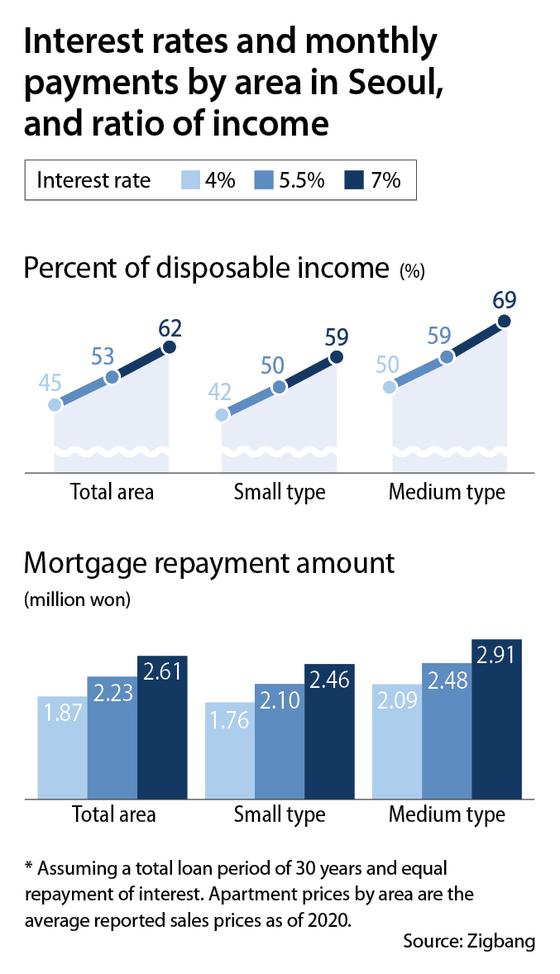Koreans becoming 'property poor' as rates rise, prices fall
Published: 19 Jun. 2022, 15:00
![A real estate agent's office in Junggye-dong, Nowon District, shows prices of apartments. [NEWS1]](https://koreajoongangdaily.joins.com/data/photo/2022/06/19/fd1eab2c-d68c-4133-a125-9344e17ce46b.jpg)
A real estate agent's office in Junggye-dong, Nowon District, shows prices of apartments. [NEWS1]
One 40 year old homeowner is looking at an extra 300,000 won ($232) in monthly expenses as rates rise.
He bought an apartment in Mapo District, western Seoul, in 2020 for 1.3 billion won, took out a 400-million-won mortgage and tapped other sources of credit for 100 million won.
The homeowner's borrowings had a rate of 2 percent, variable, and he was paying about 2 million won a month in principal and interest.
Now, rates are rising, leaving him with higher payments, and the property market has turned.
Earlier this week, the U.S. Federal Reserve increased rates by 75 basis points, the first such "giant step" in 28 years. Another such increase is possible at the next meeting, in July. The Bank of Korea is compelled to keep up with these adjustments and will likely continue rising rates.
Right on cue and following the laws of economics, property prices are falling.
According to a survey by the Korea Real Estate Board, apartment prices in Seoul fell 0.02 percent this week on week, a bigger drop than last week's 0.01 percent. Apartment prices have been declining for three weeks straight.
In Nowon District, apartment prices declined 0.03 percent last week and 0.04 percent this week, and Gangbuk and Dobong Districts both turned downward this week as well.

The buying trend is weakening, and trade is slow. According to a survey by Asil, 63,934 apartments are for sale in Seoul as of Thursday, up 1.7 percent from a week ago.
The number of apartment transactions in Seoul in May, counted by the Seoul Real Estate Information Plaza, was 1,505, less than a third of the 4,901 in the same period last year. In June, only 245 transactions have been recorded so far, and not a single transaction was made in Dobong and Jongno Districts.
Mortgage rates, currently at 4 percent, are forecast to hit 7 percent by the end of the year.
In Korea, 80.5 percent of mortgages were variable as of March, according to the central bank.
Last year, mortgage payments were 45 percent of disposable income. If rates rise to 7 percent, the ratio rises to 62 percent.
Many people purchased during the fear-of-missing-out panic of 2020. If rates rise and the value of the properties falls, these people could become "property poor."
"The higher the interest rate, the more polarization between regions, generations, and income levels will increase," said Seo Jin-hyeong, co-representative of the Fair Housing Forum and professor at Kyungin Women's University. "The suffering of homeowners with low income levels may intensify."
BY KIM WON [lim.jeongwon@joongang.co.kr]










with the Korea JoongAng Daily
To write comments, please log in to one of the accounts.
Standards Board Policy (0/250자)